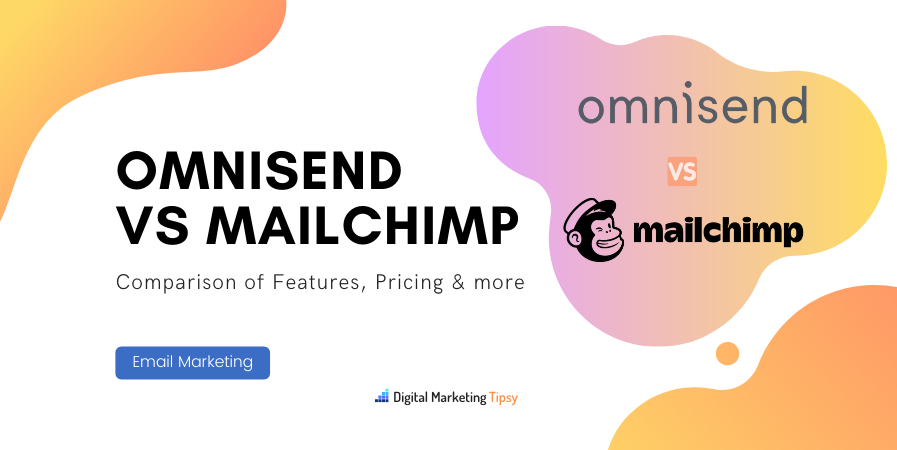Are you looking for a comprehensive Omnisend vs Mailchimp comparison analysis?
You have arrived at the right blog post as we will compare Omnisend & Mailchimp features, pricing, use case, and much more.
Before going any further, can we agree on the fact that email marketing has become the lifeline for promoting and growing any kind of business?
I bet so… And, if this wasn’t the case, you would not have gone on the spree to find the best email marketing software for your business.
Naturally, while you were searching, it’s evident that names like Mailchimp and Omnisend appeared in the majority of listicles.
And, now you are here…
Trying to decode which among Mailchimp vs Omnisend would be better for you.
So without any further ado, let’s jump straight to the action and first explore the common traits in both of the software.
Omnisend & Mailchimp – Similarities Between The Two Apps
While this article is mainly about the differences and comparison, there are certain core aspects that both the software offer.
Here are some of them –
- They have a good reputation for providing email marketing (different use cases though).
- You can find email list management and segmentation features in both tools.
- Both the software provide pre-built email templates to save time and manual efforts.
- Omnisend & Mailchimp, both allow you to create sign up forms to capture leads.
- There are tons of integration options available for the software.
- Both the apps are backed up by extensive tutorials, knowledge-base, and good customer support teams.
Despite being similar in core operations, both the software is different in usage. Not to mention, there are also certain restrictions you’d have to face while using certain features.
All of them will be discussed as we move forward in this comparison of Omnisend vs Mailchimp.
For now, let’s start with the basic introduction of the tools.
Omnisend vs Mailchimp – Brief Introduction
What Is Omnisend?
Omnisend is an online application that specializes in email marketing for eCommerce businesses.
It was launched in 2014 by the name of Soundest. Over the years, it has evolved to become one of the leading email autoresponder software.

Also, as it evolved, the basic email marketing has been upgraded to advanced with features like segmentation, automation, etc.
But most importantly, unlike other email marketing software for eCommerce, Omnisend packs an in-built SMS marketing module. The SMS suite can be used for automation as well.
What Is Mailchimp?
When it comes to email marketing, Mailchimp is one such staple software that everyone talks about, recommends, and features in their blogs, videos, etc.
The reason behind such popularity and high reputation is its experience in the email marketing field.

You’d be amazed to know that it was launched way back in 2001.
When we compare it with Omnisend whose launch was in 2014, you could clearly see why Mailchimp has dominated the email marketing realm for so long.
Unlike Omnisend, Mailchimp is widely used by small-medium sized businesses. Be it blogging, eCommerce, or anything else.
Now that you are familiar with Omnisend and Mailchimp, let’s jump to the stuff that you are here for…
Omnisend vs Mailchimp – Feature Comparison
When it comes to finding the right software for your business, it is an absolute necessity to compare its features.
So here we are, exploring and comparing all the important features in detail.
Let’s start with –
1. Email Marketing
The core feature of Mailchimp and Omnisend is email marketing. You must know which software offers a better email creation, sending/scheduling process.
Therefore, this section of feature comparison will highlight –
- How can you create email templates in both apps?
- What type of emails (HTML, text, etc.) does softwares support?
- How can you send emails to your subscribers?
1.1 Email Marketing In Omnisend
As soon as you decide to initiate an email campaign for your subscribers or customers, Omnisend impresses you by offering you the choice to send a simple campaign or make it an A/B split campaign.
A/B split email campaign is always better to understand which version of emails works better for your customers.
But for now, let’s opt for the simple email campaign.
Just like other major software, Omnisend asks you to set up your campaign by coming up with a suitable subject line, preheader, sender name & email.
After this, you will be given the choice to select the layout of the template. Currently, Omnisend offers two types of pre-built templates –
- Standard Templates – 6 templates (5 visual and 1 plain text) with pre-built layouts and readymade customizations.
- Themed Templates – A set of 12 templates that comprises dummy content, images, etc., and also with distinguished formatting.
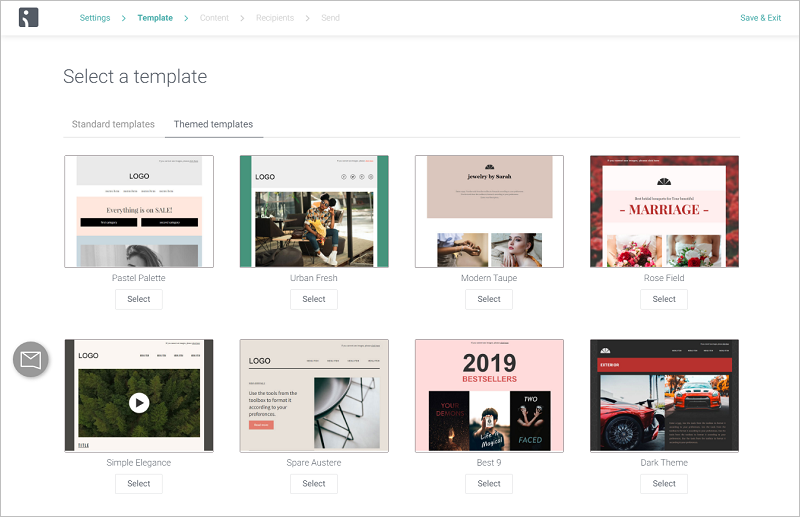
Pick the one that you find appealing and click to open it in the editor.
Speaking of which, Omnisend offers a sleek drag & drop email builder. The builder enables you to drag required email blocks and drop it in the email template, as per your requirements.
The best part about Omnisend’s builder is it offers a quiet of unique eCommerce building blocks like featured products, menu, product listing, discount, etc.

To edit any block, simply click on it and its corresponding customization settings will appear right in front of you.
One thing to note here is the Omnisend allows you to save content blocks for future use in other emails as well. While testing out Mailchimp (more on this later), this feature is missing in it.
Lastly, you get to send this campaign instantly to your subscribers. Or you can schedule it for a later time.
1.2 Email Marketing In Mailchimp
Just like Omnisend, Mailchimp also allows you to send an email campaign. Just create a new campaign and select the type of template that you are looking for.
Here it gets interesting…
Mailchimp offers a plethora of ready-made email templates options –
- There are 5 types of featured email templates.
- 9 (one among them is plain text) email templates with just the pre-customized layout.
- 90 email templates with readymade themes.
And, of course, you can also create a new template through custom coding.

Find the one that you find visually appealing and open it up in the editor.
Now, just like Omnisend, Mailchimp is also packed with a drag & drop email editor. Just like any other builder, you can select the required block and drop it in the builder area.
Although, unlike Omnisend, Mailchimp does not have the feature to dedicatedly save an email content block (and its settings) for use in other templates.

To make any changes or customize the settings of certain blocks, simply click on them and their respective settings will appear on the right-hand side of your screen.
And, once you are satisfied with your email template, you can proceed to sending or scheduling it.
To sum it up, here’s a quick overview of this section –
| Email Marketing Features | Omnisend | Mailchimp |
|---|---|---|
| Drag and Drop Builder | Yes | Yes |
| Email templates | Yes | Yes |
| A/B Testing | Yes | Yes |
| Email Scheduling | Yes | Yes |
| Unique Blocks (Coupon, Discount, etc.) | Yes | No |
| Saveable Email Blocks | Yes | No |
| Mobile Responsive | Yes | Yes |
Clearly, in this round of Mailchimp vs Omnisend, Omnisend is the clear winner when it comes to email marketing features.
2. List Management
The next core feature that one should look for in an email marketing software is email list management.
The list management primarily comprises of –
- How easily can you add or import contacts in an email list?
- Are there any means to automatically add subscribers in your lists?
- Can you segment your list on different factors?
Don’t worry, both the software offers these features.
It all comes down to which tool offers better user-friendliness and unique sub-features in it.
2.1 List Management In Omnisend
When it comes to importing contacts in your Omnisend account, the app leaves no stones unturned in pleasing you.
It allows you to –
- Add a single contact by manually entering its information
- Copy-pasting the details of your subscribers from .xls .xlsx .ods, .csv files
- Importing bulk contacts by uploading customer data from from .xls .xlsx .ods, .csv files
And, most importantly, if you are already a Mailchimp user, Omnisend allows you to automatically import and synchronize your data from your Mailchimp account.
This is possible with the help of a unique built-in tool.

Next, let’s explore some of the automated ways to add subscribers to your email list.
For this, Omnisend not only offers you a conventional signup form but it excels by offering multiple conversion-oriented means –
- Sign Up box
- Pop-ups
- Landing page
- Wheel of fortune

As I have said, in addition to a simple signup form or box, Omnisend offers signup form as pop-ups and also through landing pages.
Although, one of the best features of Omnisend is the gamification of signup forms via the Wheel of Fortune module.

As per Omnisend, this type of dynamic visualization of sign up form results in a higher opt-in rate than the conventional form or a simple pop up form.
Lastly, after accumulating leads and customers, you have the liberty to segment them on various factors.
If you find segmenting your email list troublesome, Omnisend provides some important suggestions (all readymade) for segmentation.

Simply click the “Create” button of the corresponding suggestion to check our or customize its internal settings.
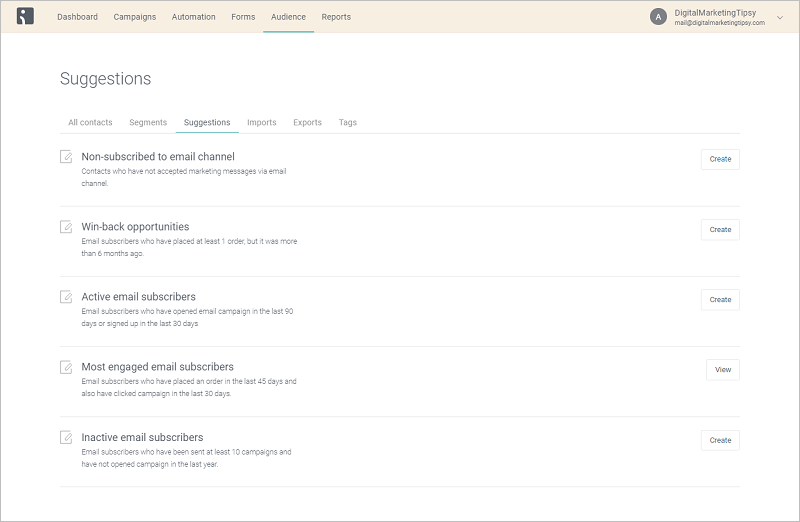
Depending on your customer’s or subscriber’s activity, your segmentation will populate the result.
2.2 List Management In Mailchimp
Mailchimp doesn’t fail to impress either when it comes to importing contacts in your email lists.
To do so, it allows you to –
- Manually enter a contact
- Upload a .csv or .txt file
- Copy-paste the data from a spreadsheet.

Every step of contacts importing is fluidic but it lacks the feature of automatically synchronizing data from other software.
Nevertheless, it covers up the missing feature by offering tons of options of sign up forms.

As you can see, it allows you to collect leads through the Facebook form as well. This is where Omnisend lacks.
Moving forward, Mailchimp is also capable of segmenting your email lists.
Although, you’d have to do all the heavy-lifting yourself as there are no segmentation suggestions just like Omnisend.
Simply select the segment that you know and filter the result through it.

Now that this section is all but done, here’s a quick overview –
| List Management Features | Omnisend | Mailchimp |
|---|---|---|
| Embeddable forms | Yes | Yes |
| Pop-ups | Yes | Yes |
| Landing Pages | Yes | Yes |
| Gamified Sign Up Forms | Yes | No |
| Advanced Segmentation | Yes | Yes |
| Segmentation Suggestions | Yes | No |
With both the software offering almost similar features, the comparison of Omnisend & Mailchimp is neck to neck in this section.
But when we consider gamified forms and segmentation suggestions in Omnisend, Mailchimp is in the deficit.
Therefore, Omnisend wins the email list management round.
3. Marketing Automation
As technology progresses, we are shifting our focus to automated systems and mechanisms. The same is the case with email marketing suites.
Luckily, both the software offers the marketing automation feature. All you need to do is set it up once and it will function automatically (according to customer/subscriber actions and behavior).
Since both of them offer the same feature, the stuff that you should compare are –
- Does the software offer any ready-made automation templates?
- Which factors can trigger the automation series?
- Is there any omnichannel marketing automation feature?
- Which software has a more advanced automation suite?
Let’s compare Omnisend vs Mailchimp on the basis of this ground –
3.1 Marketing Automation In Omnisend
Just when you think that there isn’t any way in which Omnisend can impress you anymore, that’s where it introduces you with its marketing automation feature.
“Why am I blown away by its automation module?” – you ask?
Well, because in addition to email automation, it allows you to implement SMS automation in a single workflow as well.
That’s not all… To reap maximum benefits, a single automation workflow can include multiple (omni) channels like email, SMS, web push notifications, Facebook messenger, etc.
Everything is customizable in its settings.
And, did I forget about telling you that it offers a plethora of ready-made workflow templates?
Well now that you know, you can save your time by choosing the required workflow instead of creating one from scratch.

When it comes to editing the workflow, you can notice that Omnisend offers a complete visual editor. You can customize trigger settings, include waiting periods, select email templates that must be sent, and much more visually.
In addition to this, Omnisend’s automation builder is very flexible too. Simple because it allows you to create basic as well as complex workflows.
No matter how many conditions you include or how many triggering actions you select, Omnisend will take care of it efficiently.
And, not to mention, you can also include A/B split testing in marketing automation as well.
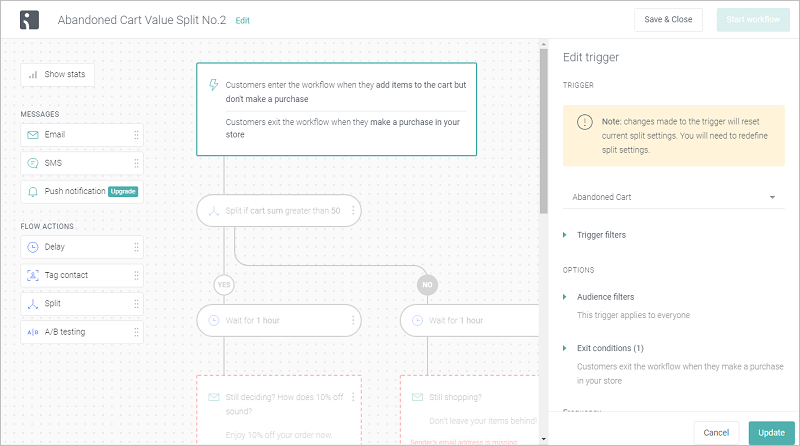
Lastly, I would like to point out that Omnisend also suggests to you what omnichannel platforms would work fine with the corresponding automation workflow.
3.2 Marketing Automation In Mailchimp
How could Mailchimp stay behind in the race of marketing automation? After all, the software has a reputation to maintain.
Just like Omnisend, Mailchimp also offers a set of ready-made automation templates that you can use to save time and manual efforts.
Also, to make it convenient for you, Mailchimp categorizes its templates into different categories. They are – Audience, eCommerce, Marketing, and Date & Special Events.

Like always, pick the one that you need.
And, once it opens up in the editor, you have the liberty to edit or customize it as per your needs.
A couple of things that I noticed here is that the workflow editing is somewhat restricted in Mailchimp. It is not as flexible or smooth as Omnisend.
Moreover, you cannot create complex automation workflows in Mailchimp.
Lastly, I also found that you’d have to create a separate workflow for automation on a different channel. Omnichannel marketing for a single workflow is not possible in Mailchimp.
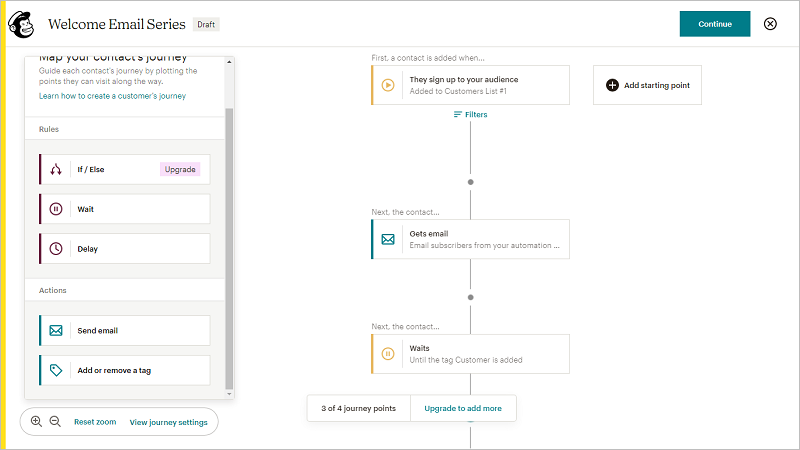
Yes, adding triggers and tags is handled well in Mailchimp.
After comparing the marketing automation, here’s what I have found –
| Marketing Automation Features | Omnisend | Mailchimp |
|---|---|---|
| Visual Automation Workflow | Yes | No |
| Workflow Templates | Yes | Yes |
| A/B Conditional Splits | Yes | No |
| Omnichannel Marketing | Yes | No |
| Push Notifications | Yes | No |
| SMS Marketing | Yes (via an inbuilt module) | Yes (via Integration) |
It’s safe to say that Omnisend has a better marketing automation feature than Mailchimp.
4. Integrations
If in any way you feel that you need extra features that a simple email marketing tool can’t provide, you can, of course, integrate you with third-party applications.
Both the software offers an extensive set of APIs, using which you can integrate any applications.
And, not to forget, there are direct integration options as well. So without any further delay, let’s compare the set of integrating options between Omnisend vs Mailchimp –
4.1 Integrations In Omnisend
First and foremost, to use Omnisend, you must first integrate it with your online eCommerce store.
Fortunately, no matter which eCommerce platform you are using, Omnisend offers integration with them.
Here’s a list of eCommerce platforms that is available for direct integration –
- Shopify
- BigCommerce
- Woocommerce
- Magento
- OpenCart
- Drupal Commerce
- Volusion
Apart from this, to boost the performance of your business, it offers integration with several other apps that are closely related to eCommerce businesses.
Here are some of them –
- Signup Forms – Email Pirate, Wheelio, Email Collection Bar, Privy, Optimonk, etc.
- Rewards, Competition & Reviews – Yotpo, Stamped.io, LoyaltyLion, Coopt Campaigns, Gleam, etc.
- CRM or Customer support – Gorgias, Tidio Live Chat, and Intercom.
- Shipping – ShipStation, AfterShip, and Easyship.
And, of course, you can connect any apps through Zapier.
4.2 Integrations In Mailchimp
I think by now you know how much I emphasize the expertise and experience level of Mailchimp in email marketing.
Because of this, it has the biggest array of apps available for integration.
Since the list is long, Mailchimp makes it convenient for you by categorizing the integration list –
- Direct Integrations
- E-commerce
- Website Builder
- Custom Website
- Event
- Design
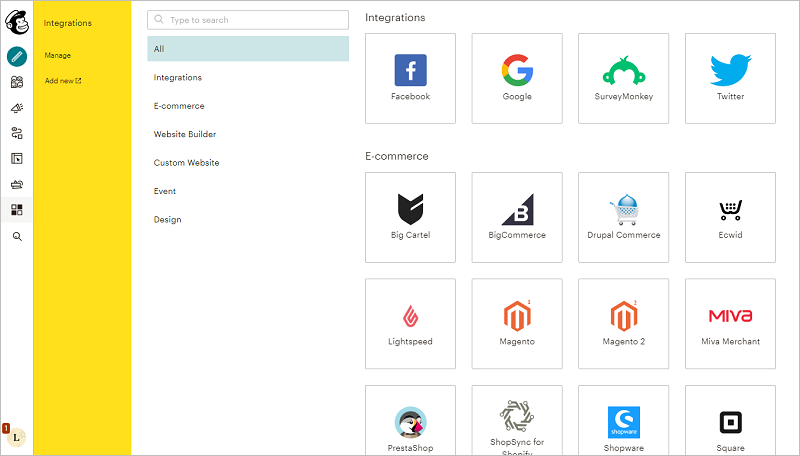
One thing you should keep in mind here is that Mailchimp has recently parted its ways from Shopify.
Simply said, Mailchimp does not provide direct integration with Shopify like Omnisend. Although, you can use mediator software to integrate them.
That being said, it’s evident that Mailchimp comes out on top in the integrations section.
This brings us to the point where we must discuss, how much would it cost for you to use either of the services.
Omnisend vs Mailchimp – Pricing Comparison
The final showdown of the comparison battle between Omnisend & Mailchimp comes down to their pricing.
After all, you must know how much it would cost to opt for either of the two software.
If you would look at the pricing model of these apps, you’d notice that both of them offer a free plan. When it comes to subscriptions, Omnisend offers more flexibility by allowing you to choose monthly or yearly billing cycles. On the other hand, Mailchimp only comes with the monthly billing option.
Apart from this, the pricing is built on the number of contacts and how many emails you can send in a month (different for each plan). And, as you go higher in the hierarchy of plans, you’d unlock more advanced features.
Pricing Of Omnisend
To kick things off, Omnisend now offers a new forever free plan. This free plan allows you to send 500 emails per month to 250 contacts, display up to 500 web push notifications, and send 60 international SMSs.
In the free plan, you can test out all the email marketing modules, sign-up forms, pop-ups, landing pages, etc. You are also allowed to use automation, workflows, A/B testing, segmentation, and other advanced features as well. However, you won’t have permission to remove Omnisend branding.
At the same time, Omnisend now offers complete features and software access to the users, irrespective of which plans they pick.

- Free – The forever free plan allows you to send 500 emails to 250 contacts, send 60 international SMSs, and 500 web push notifications. You will also get access to all the other Omnisend features but with limited access.
- Standard (Email) – The plan starts at $16/month for 500 contacts and the email sending limit is 12 times the list size (i.e. 6,000 emails/month for 500 contacts). Other sub-tiers in the plan come at $20/month for 1,000 contacts, $25 for 1,500 contacts, and so on.
- Pro (Email & SMS) – For sending unlimited emails and displaying unlimited web push notifications, this plan could be the best pick. The plan starts at $59/month for 500 contacts and also offer 3,540 international SMS credits as well.
Apart from this, you’d have to pay separately for sending SMS campaigns. The pricing of which is variable and depends on the charges applicable to countries. For example, in the USA, you’d be charged $0.015/month for sending 1 SMS.
Pricing Of Mailchimp
Just like its competitor, Mailchimp also provides a very generous free plan. In this free plan, you have permission to import 2,000 contacts and send a total of 10,000 emails in a month.
In addition to this, you also get access to some of its features like marketing CRM, form & landing page builder, creative assistant, etc.
Talking about the pricing model, the plans are built on the number of contacts imported. Each plan has a specific quota of monthly email sending. And, lastly, as you upgrade, you’ll unlock more advanced features.
Here’s an overview of the Mailchimp pricing plans –
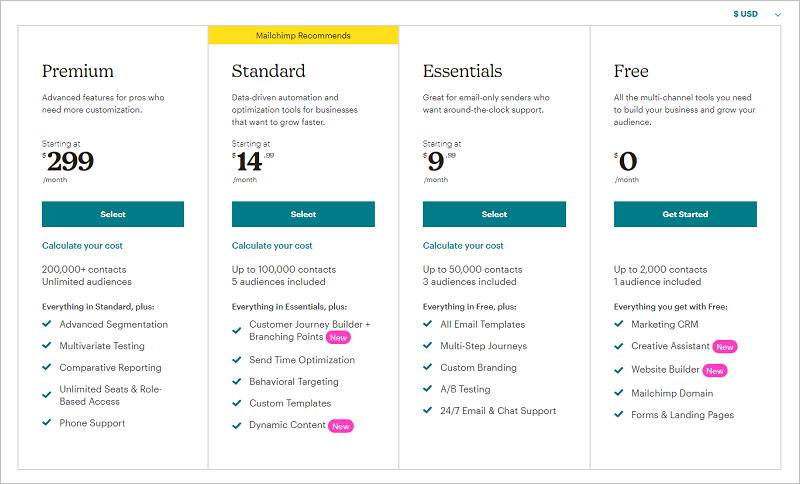
- Essentials – The plan starts at $9.99/month for 500 contacts. There are multiple sub-tiers in this plan that go up to the 50,000 contacts limit ($270/month) and up to 500,000 email sends. Other features included in this package are email templates, multi-step journeys, A/B testing, custom branding, etc.
- Standard – For the same number of contacts i.e. 500, this plan would cost you $14.99/month. The plan is flexible as it offers multiple sub-tiers that go up to the 100,000 contacts limit ($540/month) and offers a monthly emailing quota of 1.2 million. The plan package also includes features like customer journey builder, send-time optimization, behavioral targeting, and much more.
- Premium – You can subscribe to this plan that starts at $299/month for 10,000 contacts. Multiple sub-tiers are also available that go up to 200,000 contacts ($1,190/month) with up to 3 million monthly email sends. It also offers advanced features like advanced segmentation, multivariate testing, comparative reporting, and much more.
Pricing Verdict
The pricing of both the software portrays that they are very economical for the users who are just starting out.
But as you or your business grows, your needs will increase and so does your bill.
However, if we are purely talking about the sum of money required to invest in the software, Omnisend comes out to be cheaper than Mailchimp.
Omnisend vs Mailchimp – Final Verdict
Now that you thoroughly went through the Mailchimp vs Omnisend comparison review, I hope you have found the software that would suit your business well.
And, if you are still confused, allow me to clear it out even more…
Who should use Omnisend? – If you are closely related to eCommerce business, online store, etc., you should opt for Omnisend.
Who should use Mailchimp? – Any small-medium sized businesses who require a multi-functional email marketing suite should opt for Mailchimp.
If you have any particular queries regarding these two software, feel free to reach out to me or drop them in the comments section. I would be more than happy to help you out.
Lastly, don’t forget to check out these blogs too –

